Evolving Trends in Smart Building Research: A Scientometric Analysis
Abstract
:1. Introduction
2. Data Sources and Research Methods
2.1. Data Sources and Search Strategy
2.2. Methods of Scientometric Analysis
3. Results
3.1. Basic Description
3.1.1. Annual Publishing Trends
3.1.2. The Core Cited Journals
3.1.3. The Major Countries and Institutions
3.1.4. The Main Journals and Funding Agencies
3.2. Research Trends and Frontiers over Time
3.2.1. Keywords Co-Occurrence Analysis
3.2.2. Keyword Timeline Analysis
3.2.3. Keywords Breakout Analysis
4. Discussion
5. Conclusions
Author Contributions
Funding
Data Availability Statement
Conflicts of Interest
References
- Ferrari, S.; Zoghi, M.; Paganin, G.; Dall’O, G. A Practical Review to Support the Implementation of Smart Solutions within Neighbourhood Building Stock. Energies 2023, 16, 5701. [Google Scholar] [CrossRef]
- Apanaviciene, R.; Vanagas, A.; Fokaides, P.A. Smart Building Integration into a Smart City (SBISC): Development of a New Evaluation Framework. Energies 2020, 13, 2190. [Google Scholar] [CrossRef]
- Xu, W.; Zhang, J.; Kim, J.Y.; Huang, W.; Kanhere, S.S.; Jha, S.K.; Hu, W. The Design, Implementation, and Deployment of a Smart Lighting System for Smart Buildings. IEEE Internet Things J. 2019, 6, 7266–7281. [Google Scholar] [CrossRef]
- Datta, A. New urban utopias of postcolonial India: ‘Entrepreneurial urbanization’ in Dholera smart city, Gujarat. Dialogues Hum. Geogr. 2015, 5, 3–22. [Google Scholar] [CrossRef]
- Bakar, A.A.; Yussof, S.; Ghapar, A.A.; Sameon, S.S.; Jorgensen, B.N. A Review of Privacy Concerns in Energy-Efficient Smart Buildings: Risks, Rights, and Regulations. Energies 2024, 17, 977. [Google Scholar] [CrossRef]
- Guyot, G.; Walker, I.S.; Sherman, M.H. Performance based approaches in standards and regulations for smart ventilation in residential buildings: A summary review. Int. J. Vent. 2019, 18, 96–112. [Google Scholar] [CrossRef]
- Ding, Z.; Zheng, K.; Tan, Y. BIM research vs BIM practice: A bibliometric-qualitative analysis from China. Eng. Constr. Archit. Manag. 2022, 29, 3520–3546. [Google Scholar] [CrossRef]
- Doukari, O.; Seck, B.; Greenwood, D.; Feng, H.; Kassem, M. Towards an Interoperable Approach for Modelling and Managing Smart Building Data: The Case of the CESI Smart Building Demonstrator. Buildings 2022, 12, 362. [Google Scholar] [CrossRef]
- Genkin, M. B-SMART: A reference architecture for artificially intelligent autonomic smart buildings. Eng. Appl. Artif. Intell. 2023, 121, 106063. [Google Scholar] [CrossRef]
- Lee, E.-K.; Chu, P.; Gadh, R. Fine-Grained Access to Smart Building Energy Resources. IEEE Internet Comput. 2013, 17, 48–56. [Google Scholar] [CrossRef]
- Najafi-Ghalelou, A.; Zare, K.; Nojavan, S. Optimal scheduling of multi-smart buildings energy consumption considering power exchange capability. Sustain. Cities Soc. 2018, 41, 73–85. [Google Scholar] [CrossRef]
- Plageras, A.P.; Psannis, K.E.; Stergiou, C.; Wang, H.; Gupta, B.B. Efficient IoT-based sensor BIG Data collection-processing and analysis in smart buildings. Future Gener. Comput. Syst.-Int. J. Escience 2018, 82, 349–357. [Google Scholar] [CrossRef]
- Shi, Q.; Zhang, Z.; He, T.; Sun, Z.; Wang, B.; Feng, Y.; Shan, X.; Salam, B.; Lee, C. Deep learning enabled smart mats as a scalable floor monitoring system. Nat. Commun. 2020, 11, 4609. [Google Scholar] [CrossRef] [PubMed]
- Yu, Y.; Wang, C.; Gu, X.; Li, J. A novel deep learning-based method for damage identification of smart building structures. Struct. Health Monit. Int. J. 2019, 18, 143–163. [Google Scholar] [CrossRef]
- Guan, Z.; Si, G.; Zhang, X.; Wu, L.; Guizani, N.; Du, X.; Ma, Y. Privacy-Preserving and Efficient Aggregation Based on Blockchain for Power Grid Communications in Smart Communities. IEEE Commun. Mag. 2018, 56, 82–88. [Google Scholar] [CrossRef]
- Kokol, P.; Vosner, H.B. Discrepancies among Scopus, Web of Science, and PubMed coverage of funding information in medical journal articles. J. Med. Libr. Assoc. JMLA 2018, 106, 81–86. [Google Scholar] [CrossRef]
- Franceschini, F.; Maisano, D.; Mastrogiacomo, L. Empirical analysis and classification of database errors in Scopus and Web of Science. J. Informetr. 2016, 10, 933–953. [Google Scholar] [CrossRef]
- Li, K.; Rollins, J.; Yan, E. Web of Science use in published research and review papers 1997–2017: A selective, dynamic, cross-domain, content-based analysis. Scientometrics 2018, 115, 1–20. [Google Scholar] [CrossRef]
- Liu, W. The data source of this study is Web of Science Core Collection? Not enough. Scientometrics 2019, 121, 1815–1824. [Google Scholar] [CrossRef]
- Synnestvedt, M.B.; Chen, C.; Holmes, J.H. CiteSpace II: Visualization and knowledge discovery in bibliographic databases. AMIA Annu. Symp. Proc. 2005, 2005, 724–728. [Google Scholar]
- Chen, C.; Song, M. Visualizing a field of research: A methodology of systematic scientometric reviews. PLoS ONE 2019, 14, e0223994. [Google Scholar] [CrossRef] [PubMed]
- Gazni, A.; Didegah, F. Investigating different types of research collaboration and citation impact: A case study of Harvard University’s publications. Scientometrics 2011, 87, 251–265. [Google Scholar] [CrossRef]
- Liu, F. Retrieval strategy and possible explanations for the abnormal growth of research publications: Re-evaluating a bibliometric analysis of climate change. Scientometrics 2023, 128, 853–859. [Google Scholar] [CrossRef]
- Shen, C.; Zhao, S.X.; Zhou, X. The Effect of Journal Competition on Research Quality with Endogenous Choices of Open Access or Restricted Access. J. Informetr. 2023, 17, 101429. [Google Scholar] [CrossRef]
- Hu, Y.-H.; Tai, C.-T.; Liu, K.E.; Cai, C.-F. Identification of highly-cited papers using topic-model-based and bibliometric features: The consideration of keyword popularity. J. Informetr. 2020, 14, 101004. [Google Scholar] [CrossRef]
- Dong, B.; Prakash, V.; Feng, F.; O’Neill, Z. A review of smart building sensing system for better indoor environment control. Energy Build. 2019, 199, 29–46. [Google Scholar] [CrossRef]
- Minoli, D.; Sohraby, K.; Occhiogrosso, B. IoT Considerations, Requirements, and Architectures for Smart Buildings-Energy Optimization and Next-Generation Building Management Systems. IEEE Internet Things J. 2017, 4, 269–283. [Google Scholar] [CrossRef]
- Jia, M.; Komeily, A.; Wang, Y.; Srinivasan, R.S. Adopting Internet of Things for the development of smart buildings: A review of enabling technologies and applications. Autom. Constr. 2019, 101, 111–126. [Google Scholar] [CrossRef]
- Al Dakheel, J.; Del Pero, C.; Aste, N.; Leonforte, F. Smart buildings features and key performance indicators: A review. Sustain. Cities Soc. 2020, 61, 102328. [Google Scholar] [CrossRef]
- Hammarfelt, B. Interdisciplinarity and the intellectual base of literature studies: Citation analysis of highly cited monographs. Scientometrics 2011, 86, 705–725. [Google Scholar] [CrossRef]
- Liu, Y.; Jiang, M.; Hu, L.; He, Z. The statistical nature of h-index of a network node and its extensions. J. Informetr. 2023, 17, 101424. [Google Scholar] [CrossRef]
- Badar, K.; Hite, J.M.; Badir, Y.F. Examining the relationship of co-authorship network centrality and gender on academic research performance: The case of chemistry researchers in Pakistan. Scientometrics 2013, 94, 755–775. [Google Scholar] [CrossRef]
- Tuan, A.N.; Aiello, M. Energy intelligent buildings based on user activity: A survey. Energy Build. 2013, 56, 244–257. [Google Scholar]
- Siano, P. Demand response and smart grids—A survey. Renew. Sustain. Energy Rev. 2014, 30, 461–478. [Google Scholar] [CrossRef]
- Reingewertz, Y.; Lutmar, C. Academic in-group bias: An empirical examination of the link between author and journal affiliation. J. Informetr. 2018, 12, 74–86. [Google Scholar] [CrossRef]
- Jin, X.; Bao, H.; Luo, Y.; Wang, X. Technical research and demonstration projects of the intelligent building for smart grid in China. Energy Build. 2024, 307, 113987. [Google Scholar] [CrossRef]
- Guan, H.; Huang, T.; Guo, X. Knowledge Mapping of Tourist Experience Research: Based on CiteSpace Analysis. Sage Open 2023, 13, 21582440231166844. [Google Scholar] [CrossRef]
- Abbasi, A.; Hossain, L.; Leydesdorff, L. Betweenness centrality as a driver of preferential attachment in the evolution of research collaboration networks. J. Informetr. 2012, 6, 403–412. [Google Scholar] [CrossRef]
- Wang, C.; Che, Y.; Xia, M.; Lin, C.; Chen, Y.; Li, X.; Chen, H.; Luo, J.; Fan, G. The Evolution and Future Directions of Green Buildings Research: A Scientometric Analysis. Buildings 2024, 14, 345. [Google Scholar] [CrossRef]
- An, L.; Lin, X.; Yu, C.; Zhang, X. Measuring and visualizing the contributions of Chinese and American LIS research institutions to emerging themes and salient themes. Scientometrics 2015, 105, 1605–1634. [Google Scholar] [CrossRef]
- Huang, M.-H.; Huang, M.-J. An analysis of global research funding from subject field and funding agencies perspectives in the G9 countries. Scientometrics 2018, 115, 833–847. [Google Scholar] [CrossRef]
- Alvarez-Bornstein, B.; Morillo, F.; Bordons, M. Funding acknowledgments in the Web of Science: Completeness and accuracy of collected data. Scientometrics 2017, 112, 1793–1812. [Google Scholar] [CrossRef]
- Liu, W.; Tang, L.; Hu, G. Funding information in Web of Science: An updated overview. Scientometrics 2020, 122, 1509–1524. [Google Scholar] [CrossRef]
- Maltseva, D.; Batagelj, V. Towards a systematic description of the field using keywords analysis: Main topics in social networks. Scientometrics 2020, 123, 357–382. [Google Scholar] [CrossRef]
- Chen, G.; Xiao, L. Selecting publication keywords for domain analysis in bibliometrics: A comparison of three methods. J. Informetr. 2016, 10, 212–223. [Google Scholar] [CrossRef]
- Zhang, X.; Xie, Q.; Song, C.; Song, M. Mining the evolutionary process of knowledge through multiple relationships between keywords. Scientometrics 2022, 127, 2023–2053. [Google Scholar] [CrossRef]
- Li, P.; Lu, Y.; Yan, D.; Xiao, J.; Wu, H. Scientometric mapping of smart building research: Towards a framework of human-cyber-physical system (HCPS). Autom. Constr. 2021, 129, 103776. [Google Scholar] [CrossRef]
- Santos, B.; Soares, A.; Nguyen, T.-A.; Min, D.-K.; Lee, J.-W.; Silva, F.-A. IoT Sensor Networks in Smart Buildings: A Performance Assessment Using Queuing Models. Sensors 2021, 21, 5660. [Google Scholar] [CrossRef]
- Kaur, A.; Bhatia, M. Stochastic game network based model for disaster management in smart industry. J. Ambient Intell. Humaniz. Comput. 2021, 14, 5151–5169. [Google Scholar] [CrossRef]
- Dou, Y.; Li, T.; Li, L.; Zhang, Y.; Li, Z. Tracking the Research on Ten Emerging Digital Technologies in the AECO Industry. J. Constr. Eng. Manag. 2023, 149, 03123003. [Google Scholar] [CrossRef]
- Anthopoulos, L.; Kazantzi, V. Urban energy efficiency assessment models from an AI and big data perspective: Tools for policy makers. Sustain. Cities Soc. 2022, 76, 103492. [Google Scholar] [CrossRef]
- Djenouri, D.; Laidi, R.; Djenouri, Y.; Balasingham, I. Machine Learning for Smart Building Applications: Review and Taxonomy. ACM Comput. Surv. 2019, 52, 24. [Google Scholar] [CrossRef]
- Omrany, H.; Al-Obaidi, K.M.; Husain, A.; Ghaffarianhoseini, A. Digital Twins in the Construction Industry: A Comprehensive Review of Current Implementations, Enabling Technologies, and Future Directions. Sustainability 2023, 15, 10908. [Google Scholar] [CrossRef]
- Tang, S.; Shelden, D.R.; Eastman, C.M.; Pishdad-Bozorgi, P.; Gao, X. A review of building information modeling (BIM) and the internet of things (IoT) devices integration: Present status and future trends. Autom. Constr. 2019, 101, 127–139. [Google Scholar] [CrossRef]
- Aliero, M.S.; Qureshi, K.N.; Pasha, M.F.; Ghani, I.; Yauri, R.A. Systematic Mapping Study on Energy Optimization Solutions in Smart Building Structure: Opportunities and Challenges. Wirel. Pers. Commun. 2021, 119, 2017–2053. [Google Scholar] [CrossRef]
- Cvar, N.; Trilar, J.; Kos, A.; Volk, M.; Duh, E.S. The Use of IoT Technology in Smart Cities and Smart Villages: Similarities, Differences, and Future Prospects. Sensors 2020, 20, 3897. [Google Scholar] [CrossRef]
- Geng, Y.; Zhang, N.; Zhu, R. Research progress analysis of sustainable smart grid based on CiteSpace. Energy Strategy Rev. 2023, 48, 101111. [Google Scholar] [CrossRef]
- Rousseeuw, P.J. Silhouettes: A graphical aid to the interpretation and validation of cluster analysis. J. Comput. Appl. Math. 1987, 20, 53–65. [Google Scholar] [CrossRef]
- Barker, O. Realizing the Promise of the Internet of Things in Smart Buildings. Computer 2020, 53, 76–79. [Google Scholar] [CrossRef]
- Curry, E.; Hasan, S.; Kouroupetroglou, C.; Fabritius, W.; ul Hassan, U.; Derguech, W. Internet of Things Enhanced User Experience for Smart Water and Energy Management. IEEE Internet Comput. 2018, 22, 18–28. [Google Scholar] [CrossRef]
- Wang, W.-C.; Dwijendra, N.K.A.; Sayed, B.T.; Alvarez, J.R.N.; Al-Bahrani, M.; Alviz-Meza, A.; Cardenas-Escrocia, Y. Internet of Things Energy Consumption Optimization in Buildings: A Step toward Sustainability. Sustainability 2023, 15, 6475. [Google Scholar] [CrossRef]
- Verma, A.; Prakash, S.; Srivastava, V.; Kumar, A.; Mukhopadhyay, S.C. Sensing, Controlling, and IoT Infrastructure in Smart Building: A Review. IEEE Sens. J. 2019, 19, 9036–9046. [Google Scholar] [CrossRef]
- Park, S.; Park, S.; Byun, J.; Park, S. Design of a mass-customization-based cost-effective Internet of Things sensor system in smart building spaces. Int. J. Distrib. Sens. Netw. 2016, 12, 1550147716660895. [Google Scholar] [CrossRef]
- Nabavi, S.A.; Motlagh, N.H.; Zaidan, M.A.; Aslani, A.; Zakeri, B. Deep Learning in Energy Modeling: Application in Smart Buildings With Distributed Energy Generation. IEEE Access 2021, 9, 125439–125461. [Google Scholar] [CrossRef]
- Manivannan, M.; Najafi, B.; Rinaldi, F. Machine Learning-Based Short-Term Prediction of Air-Conditioning Load through Smart Meter Analytics. Energies 2017, 10, 1905. [Google Scholar] [CrossRef]
- Nedbal, C.; Cerrato, C.; Jahrreiss, V.; Castellani, D.; Pietropaolo, A.; Galosi, A.B.; Somani, B.K. The role of ‘artificial intelligence, machine learning, virtual reality, and radiomics’ in PCNL: A review of publication trends over the last 30 years. Ther. Adv. Urol. 2023, 15, 17562872231196676. [Google Scholar] [CrossRef]
- Liu, D.; Che, S.; Zhu, W. Visualizing the Knowledge Domain of Academic Mobility Research from 2010 to 2020: A Bibliometric Analysis Using CiteSpace. Sage Open 2022, 12, 21582440211068510. [Google Scholar] [CrossRef]
- Shao, H.; Kim, G.; Li, Q.; Newman, G. Web of Science-Based Green Infrastructure: A Bibliometric Analysis in CiteSpace. Land 2021, 10, 711. [Google Scholar] [CrossRef]
- Cao, X.; Furuoka, F.; Rasiah, R. Knowledge Mapping of Industrial Upgrading Research: A Visual Analysis Using CiteSpace. Sustainability 2023, 15, 16547. [Google Scholar] [CrossRef]
- Rajaoarisoa, L.; M’Sirdi, N.K.; Sayed-Mouchaweh, M.; Clavier, L. Decentralized fault-tolerant controller based on cooperative smart-wireless sensors in large-scale buildings. J. Netw. Comput. Appl. 2023, 214, 103605. [Google Scholar] [CrossRef]
- Fei, F.; Zhou, S.; Mai, J.D.; Li, W.J. Development of an Indoor Airflow Energy Harvesting System for Building Environment Monitoring. Energies 2014, 7, 2985–3003. [Google Scholar] [CrossRef]
- Su, J.-M.; Huang, C.-F. An easy-to-use 3D visualization system for planning context-aware applications in smart buildings. Comput. Stand. Interfaces 2014, 36, 312–326. [Google Scholar] [CrossRef]
- Kanthila, C.; Boodi, A.; Beddiar, K.; Amirat, Y.; Benbouzid, M. Building Occupancy Behavior and Prediction Methods: A Critical Review and Challenging Locks. IEEE Access 2021, 9, 79353–79372. [Google Scholar] [CrossRef]
- Merabet, G.H.; Essaaidi, M.; Ben Haddou, M.; Qolomany, B.; Qadir, J.; Anan, M.; Al-Fuqaha, A.; Abid, M.R.; Benhaddou, D. Intelligent building control systems for thermal comfort and energy-efficiency: A systematic review of artificial intelligence-assisted techniques. Renew. Sustain. Energy Rev. 2021, 145, 111116. [Google Scholar] [CrossRef]
- Belafi, Z.; Hong, T.; Reith, A. Smart building management vs. intuitive human control-Lessons learnt from an office building in Hungary. Build. Simul. 2017, 10, 811–828. [Google Scholar] [CrossRef]
- Park, J.Y.; Dougherty, T.; Fritz, H.; Nagy, Z. LightLearn: An adaptive and occupant centered controller for lighting based on reinforcement learning. Build. Environ. 2019, 147, 397–414. [Google Scholar] [CrossRef]
- Liberati, F.; Di Giorgio, A.; Giuseppi, A.; Pietrabissa, A.; Habib, E.; Martirano, L. Joint Model Predictive Control of Electric and Heating Resources in a Smart Building. IEEE Trans. Ind. Appl. 2019, 55, 7015–7027. [Google Scholar] [CrossRef]
- Rosato, A.; Panella, M.; Andreotti, A.; Mohammed, O.A.; Araneo, R. Two-stage dynamic management in energy communities using a decision system based on elastic net regularization. Appl. Energy 2021, 291, 116852. [Google Scholar] [CrossRef]
- Zekic-Susac, M.; Mitrovic, S.; Has, A. Machine learning based system for managing energy efficiency of public sector as an approach towards smart cities. Int. J. Inf. Manag. 2021, 58, 102074. [Google Scholar] [CrossRef]
- Cao, K.; Liu, Y.; Meng, G.; Sun, Q. An Overview on Edge Computing Research. IEEE Access 2020, 8, 85714–85728. [Google Scholar] [CrossRef]
- Attoue, N.; Shahrour, I.; Younes, R. Smart Building: Use of the Artificial Neural Network Approach for Indoor Temperature Forecasting. Energies 2018, 11, 395. [Google Scholar] [CrossRef]
- Lazarova-Molnar, S.; Mohamed, N. Collaborative data analytics for smart buildings: Opportunities and models. Clust. Comput. J. Netw. Softw. Tools Appl. 2019, 22, 1065–1077. [Google Scholar] [CrossRef]
- Hernandez, J.L.; de Miguel, I.; Velez, F.; Vasallo, A. Challenges and opportunities in European smart buildings energy management: A critical review. Renew. Sustain. Energy Rev. 2024, 199, 114472. [Google Scholar] [CrossRef]
- Wu, X.; Lin, J.; Xu, Z.; Zhao, C.; Lin, C.; Wang, H.; Lin, T.; Zheng, X.; Sa, B.; Zhang, Q.; et al. Defect Management and Multi-Mode Optoelectronic Manipulations via Photo-Thermochromism in Smart Windows. Laser Photonics Rev. 2021, 15, 2100211. [Google Scholar] [CrossRef]
- Lu, D.; Ma, L.-P.; Zhong, J.; Tong, J.; Liu, Z.; Ren, W.; Cheng, H.-M. Growing Nanocrystalline Graphene on Aggregates for Conductive and Strong Smart Cement Composites. ACS Nano 2023, 17, 3587–3597. [Google Scholar] [CrossRef]
- Özdemir, V.; Hekim, N. Birth of Industry 5.0: Making Sense of Big Data with Artificial Intelligence, “The Internet of Things” and Next-Generation Technology Policy. Omics 2018, 22, 65–76. [Google Scholar] [CrossRef]
- Roach, C.; Hyndman, R.; Ben Taieb, S. Non-linear mixed-effects models for time series forecasting of smart meter demand. J. Forecast. 2021, 40, 1118–1130. [Google Scholar] [CrossRef]
- Mustafa, M.N.; Abdah, M.A.A.M.; Numan, A.; Moreno-Rangel, A.; Radwan, A.; Khalid, M. Smart window technology and its potential for net-zero buildings: A review. Renew. Sustain. Energy Rev. 2023, 181, 113355. [Google Scholar] [CrossRef]
- Kim, H.; Choi, H.; Kang, H.; An, J.; Yeom, S.; Hong, T. A systematic review of the smart energy conservation system: From smart homes to sustainable smart cities. Renew. Sustain. Energy Rev. 2021, 140, 110755. [Google Scholar] [CrossRef]
- Sovacool, B.K.; Del Rio, D.D.F. Smart home technologies in Europe: A critical review of concepts, benefits, risks and policies. Renew. Sustain. Energy Rev. 2020, 120, 109663. [Google Scholar] [CrossRef]
- Chen, G.; Wang, K.; Yang, J.; Huang, J.; Chen, Z.; Zheng, J.; Wang, J.; Yang, H.; Li, S.; Miao, Y.; et al. Printable Thermochromic Hydrogel-Based Smart Window for All-Weather Building Temperature Regulation in Diverse Climates. Adv. Mater. 2023, 35. [Google Scholar] [CrossRef] [PubMed]
- Selvaraj, R.; Kuthadi, V.M.; Baskar, S. Smart building energy management and monitoring system based on artificial intelligence in smart city. Sustain. Energy Technol. Assess. 2023, 56, 103090. [Google Scholar] [CrossRef]
- Jensen, S.O.; Marszal-Pomianowska, A.; Lollini, R.; Pasut, W.; Knotzer, A.; Engelmann, P.; Stafford, A.; Reynders, G. IEA EBC Annex 67 Energy Flexible Buildings. Energy Build. 2017, 155, 25–34. [Google Scholar] [CrossRef]
- Alhamed, K.M.; Iwendi, C.; Dutta, A.K.; Almutairi, B.; Alsaghier, H.; Almotairi, S. Building construction based on video surveillance and deep reinforcement learning using smart grid power system. Comput. Electr. Eng. 2022, 103, 108273. [Google Scholar] [CrossRef]
- Alanne, K.; Sierla, S. An overview of machine learning applications for smart buildings. Sustain. Cities Soc. 2022, 76, 103445. [Google Scholar] [CrossRef]
- Verma, M.K.; Khan, D.; Yuvaraj, M. Scientometric assessment of funded scientometrics and bibliometrics research (2011–2021). Scientometrics 2023, 128, 4305–4320. [Google Scholar] [CrossRef]
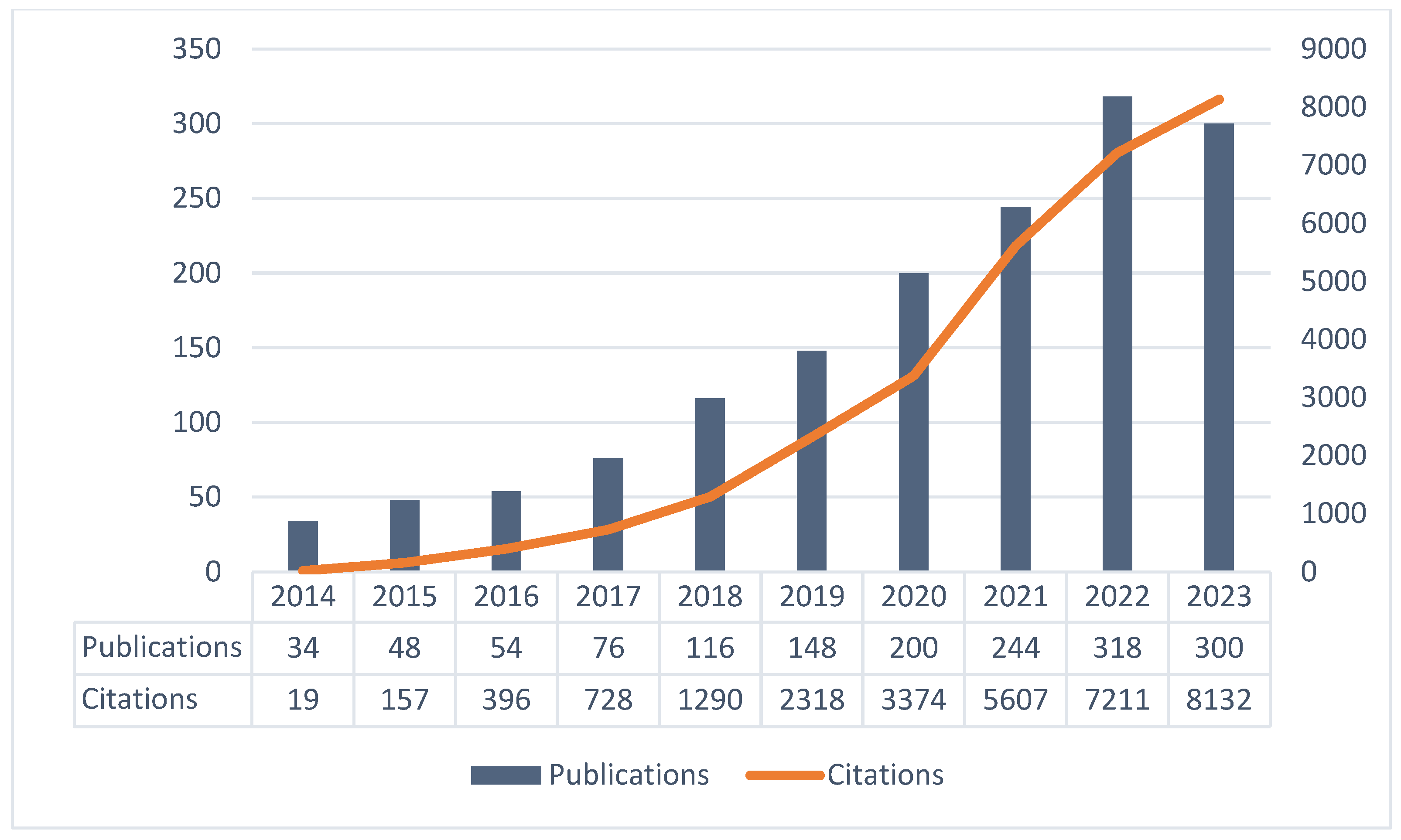
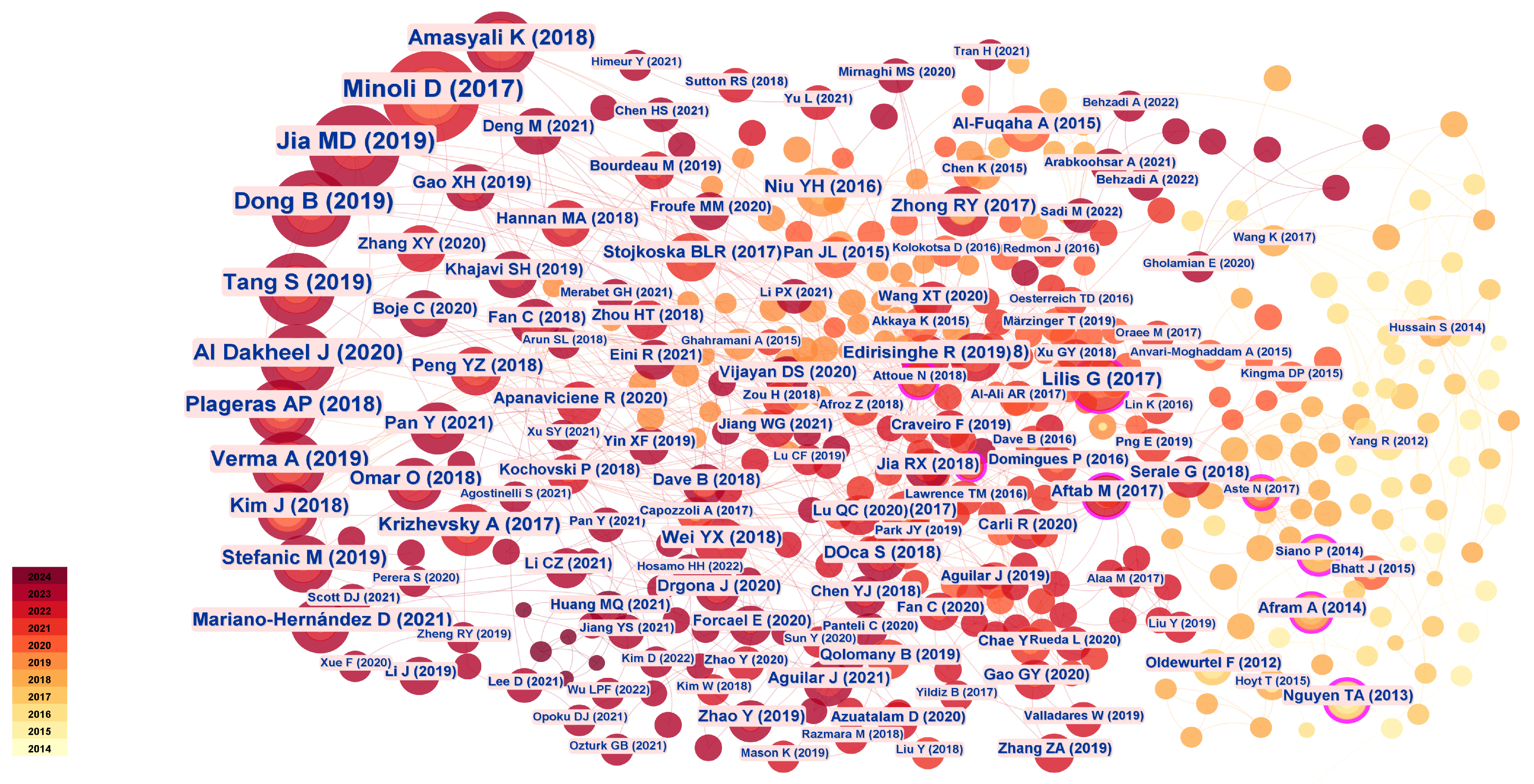
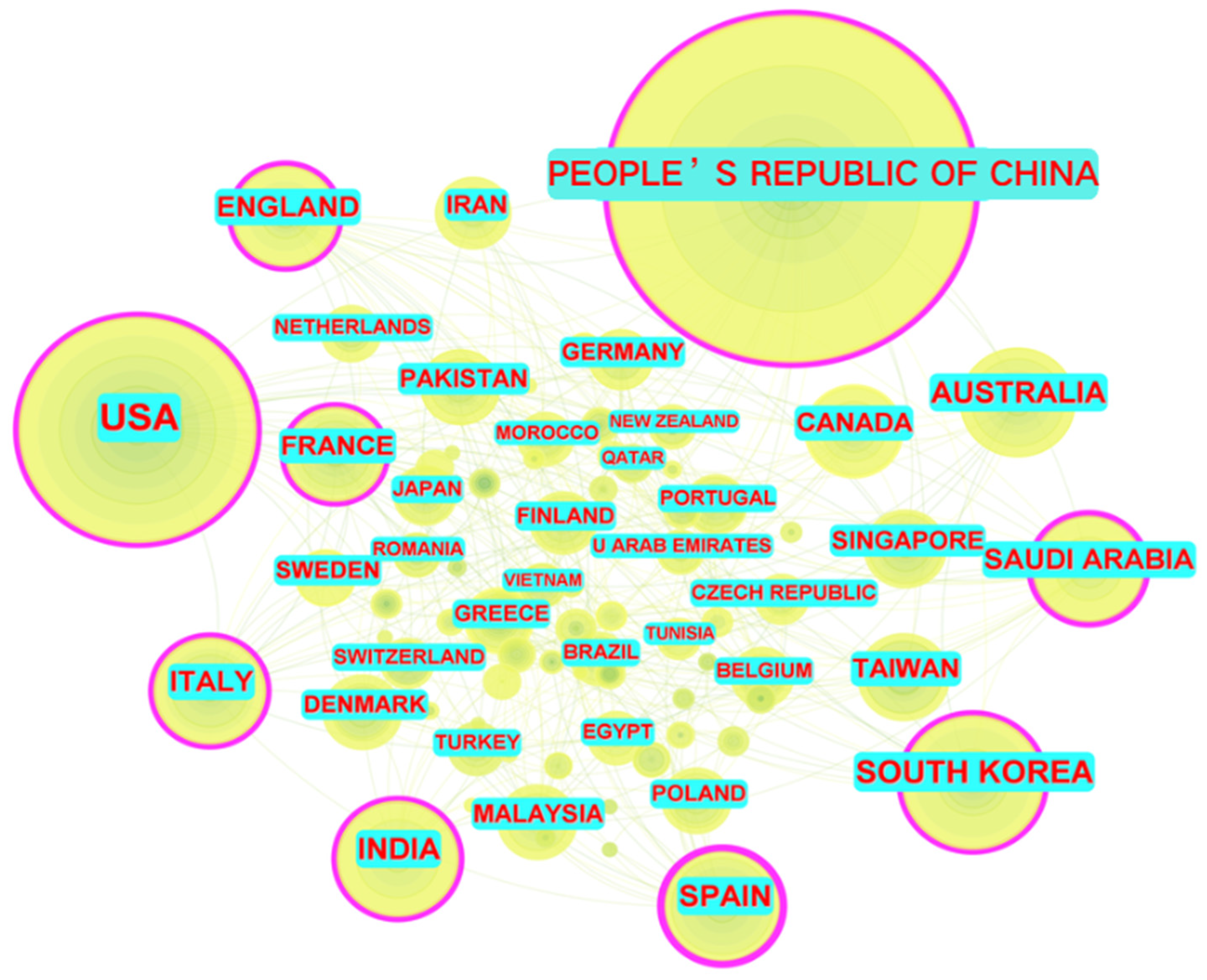


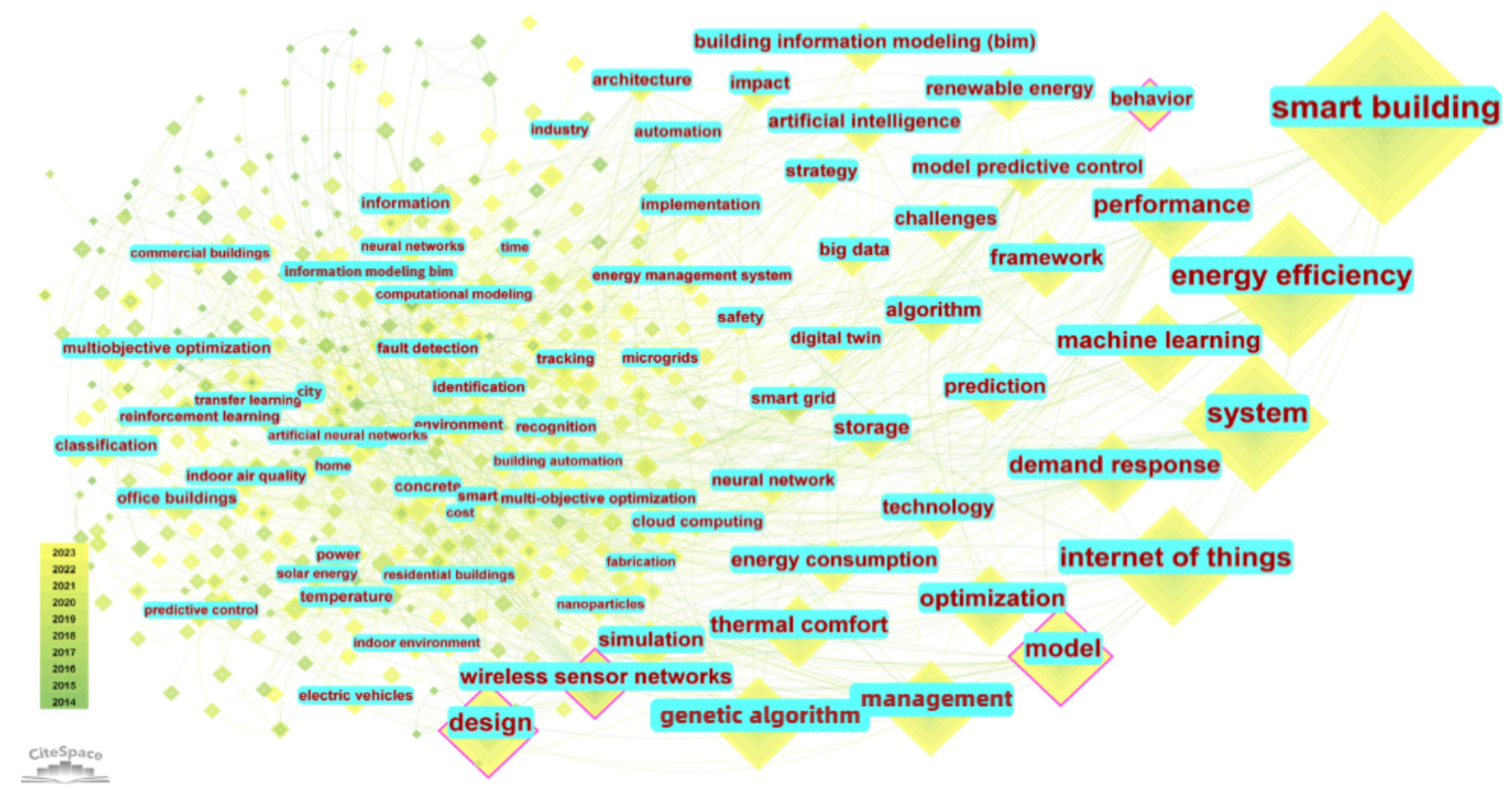
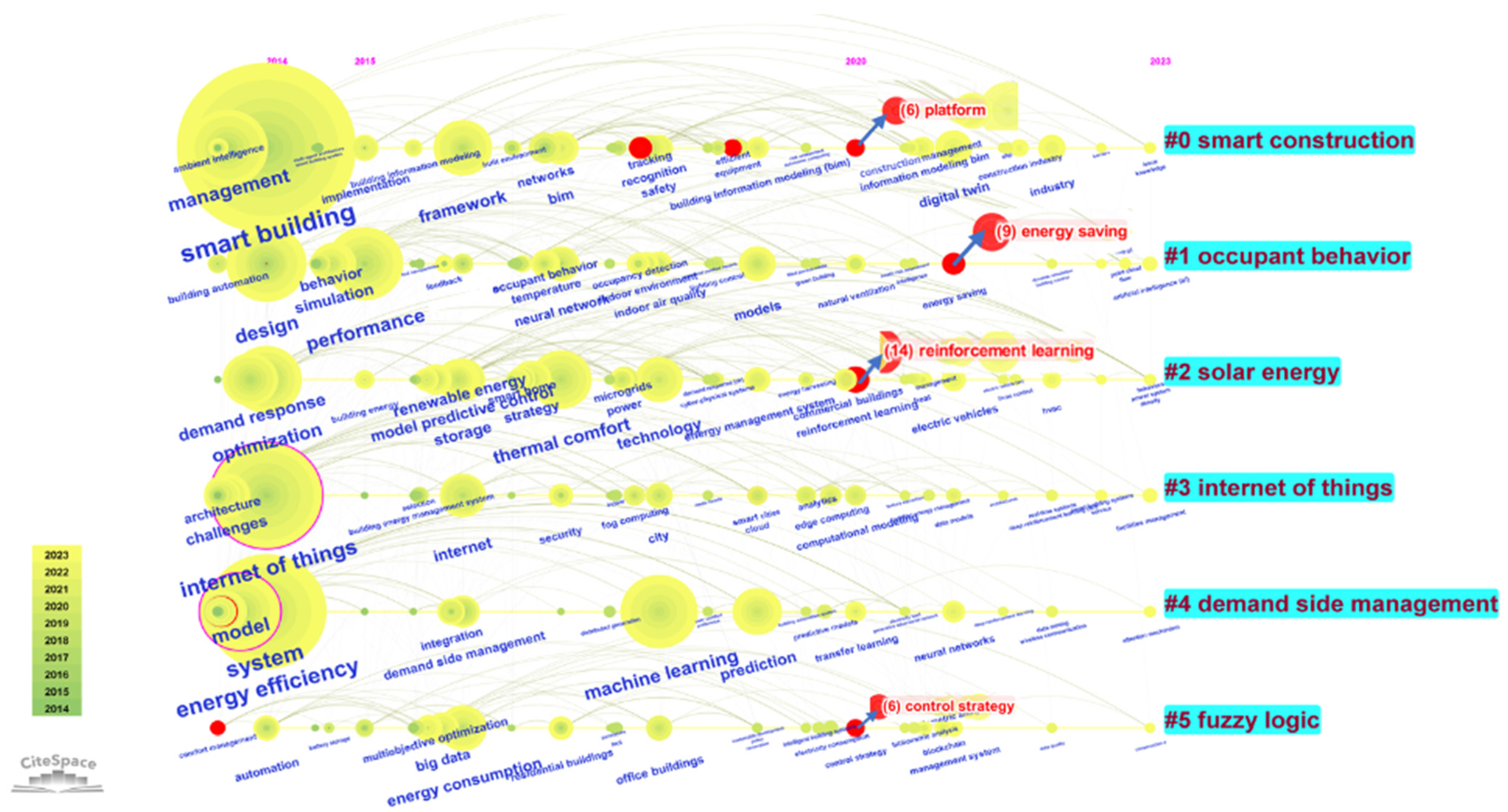
| Number | Count-Based | Centrality-Based | ||||
|---|---|---|---|---|---|---|
| Count | Centrality | Title | Count | Centrality | Title | |
| 1 | 37 | 0.06 | IoT Considerations, Requirements, and Architectures for Smart Building-Energy Optimization and Next-Generation Building Management Systems | 7 | 0.26 | Energy intelligent building based on user activity: A survey |
| 2 | 32 | 0.1 | Adopting Internet of Things for the development of smart building: A review of enabling technologies and applications | 5 | 0.25 | Demand response and smart grids-A survey |
| 3 | 26 | 0.01 | A review of smart building sensing system for better indoor environment control | 7 | 0.17 | Theory and applications of HVAC control systems—A review of model predictive control (MPC) |
| 4 | 24 | 0.07 | A review of building information modeling (BIM) and the internet of things (IoT) devices integration: Present status and future trends | 5 | 0.16 | Smart Building: Use of the Artificial Neural Network Approach for Indoor Temperature Forecasting |
| 5 | 22 | 0.02 | Smart building features and key performance indicators: A review | 8 | 0.13 | Automatic HVAC control with real-time occupancy recognition and simulation-guided model predictive control in low-cost embedded system |
| Rank | Country | Institution | ||||
|---|---|---|---|---|---|---|
| Countries | Count | Centrality | Institution | Count | Centrality | |
| 1 | China | 558 | 0.1 | Tsinghua University | 34 | 0.18 |
| 2 | USA | 247 | 0.19 | University of California System | 27 | 0.07 |
| 3 | Republic of Korea | 103 | 0.1 | University of Hong Kong | 26 | 0.08 |
| 4 | India | 73 | 0.15 | Hong Kong Polytechnic University | 26 | 0.08 |
| 5 | Spanish | 72 | 0.27 | Chinese Academy of Sciences | 24 | 0.11 |
| 6 | Australia | 70 | 0.02 | French National Center for Scientific Research (CNRS) | 20 | 0.07 |
| 7 | Italy | 69 | 0.12 | Southeast University—China | 20 | 0.09 |
| 8 | UK | 62 | 0.15 | Zhejiang University | 19 | 0.02 |
| 9 | Saudi Arabia | 56 | 0.11 | United States Department of Energy (DOE) | 19 | 0.15 |
| 10 | France | 53 | 0.12 | Aalborg University | 19 | 0.11 |
| Number | Count | Centrality | Keywords | Count | Centrality | Keywords |
|---|---|---|---|---|---|---|
| 1 | 587 | 0.04 | smart building | 40 | 0.13 | behavior |
| 2 | 276 | 0.05 | energy efficiency | 131 | 0.12 | model |
| 3 | 268 | 0.07 | system | 63 | 0.11 | wireless sensor networks |
| 4 | 204 | 0.09 | internet of things | 129 | 0.1 | design |
| 5 | 131 | 0.12 | model | 122 | 0.1 | performance |
| 6 | 129 | 0.06 | management | 204 | 0.09 | internet of things |
| 7 | 129 | 0.06 | genetic algorithm | 42 | 0.08 | model predictive control |
| 8 | 129 | 0.1 | design | 268 | 0.07 | system |
| 9 | 122 | 0.1 | performance | 17 | 0.07 | artificial neural network |
| 10 | 106 | 0.02 | machine learning | 15 | 0.07 | recognition |
| 11 | 105 | 0.06 | demand response | 129 | 0.06 | management |
| 12 | 95 | 0.02 | optimization | 129 | 0.06 | genetic algorithm |
| 13 | 77 | 0.03 | thermal comfort | 105 | 0.06 | demand response |
| Phase Summaries | Number | Keywords | Strength | Begin | 2014–2023 |
|---|---|---|---|---|---|
| Early Research Focus | 1 | wireless sensor networks | 8.51 | 2014 |  |
| 2 | smart grid | 7.49 | 2014 |  | |
| 3 | comfort management | 3.09 | 2014 |  | |
| 4 | indoor localization | 1.58 | 2014 |  | |
| 5 | building automation | 1.3 | 2014 |  | |
| Intelligent Control | 6 | fuzzy logic | 1.95 | 2015 |  |
| 7 | predictive control | 1.54 | 2015 |  | |
| Occupant Experience | 8 | heat transfer | 1.7 | 2017 |  |
| 9 | occupant behavior | 1.35 | 2017 |  | |
| Building Management and Optimization | 10 | fault detection | 1.92 | 2018 |  |
| 11 | building management system | 1.74 | 2018 |  | |
| 12 | facility management | 1.23 | 2019 |  | |
| 13 | building energy management system | 1.45 | 2020 |  | |
| 14 | mechanical property | 3.24 | 2020 |  | |
| Application of Emerging Technologies | 15 | reinforcement learning | 2.68 | 2020 |  |
| 16 | edge computing | 1.72 | 2020 |  | |
| 17 | energy saving | 2.93 | 2021 |  | |
| 18 | neural networks | 1.48 | 2021 |  | |
| 19 | data models | 1.3 | 2021 |  | |
| 20 | electrical conductivity | 1.3 | 2021 |  |
Disclaimer/Publisher’s Note: The statements, opinions and data contained in all publications are solely those of the individual author(s) and contributor(s) and not of MDPI and/or the editor(s). MDPI and/or the editor(s) disclaim responsibility for any injury to people or property resulting from any ideas, methods, instructions or products referred to in the content. |
© 2024 by the authors. Licensee MDPI, Basel, Switzerland. This article is an open access article distributed under the terms and conditions of the Creative Commons Attribution (CC BY) license (https://creativecommons.org/licenses/by/4.0/).
Share and Cite
Haiyirete, X.; Zhang, W.; Gao, Y. Evolving Trends in Smart Building Research: A Scientometric Analysis. Buildings 2024, 14, 3023. https://doi.org/10.3390/buildings14093023
Haiyirete X, Zhang W, Gao Y. Evolving Trends in Smart Building Research: A Scientometric Analysis. Buildings. 2024; 14(9):3023. https://doi.org/10.3390/buildings14093023
Chicago/Turabian StyleHaiyirete, Xuekelaiti, Wenjuan Zhang, and Yu Gao. 2024. "Evolving Trends in Smart Building Research: A Scientometric Analysis" Buildings 14, no. 9: 3023. https://doi.org/10.3390/buildings14093023




